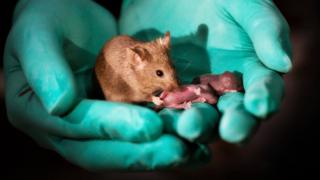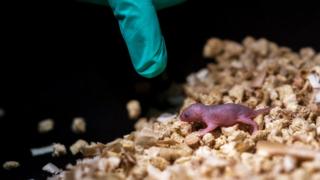
Image copyright
Leyun Wang
This adult mouse has two mums and no dad, was healthy and able to have healthy pups of her own
Baby mice have been made with two mums and no dad, say researchers at the Chinese Academy of Sciences.
It took a substantial feat of genetic engineering to break the rules of reproduction.
The scientists said the “bimaternal” (two mammas) animals were healthy and went on to have pups of their own.
But there was bad news on the all-male front. Mice with double-dads were attempted, but died within days of being born.
Why even try?
The researchers were trying to answer fundamental questions about why we have sex.
Mammals, including us, can make babies only through sexual reproduction – aka you need an egg from mum and a sperm from dad.
But the rest of the natural world doesn’t play by the same rules; some female fish, reptiles, amphibians and birds can go it alone.
Welcome to the bizarre world of virgin births known officially as parthenogenesis.

Image copyright
Getty Images
The Komodo dragon is one of many species able to reproduce through parthenogenesis
The aim of the Chinese researchers was to work out which rules of reproduction they needed to break to make baby mice from same-sex parents.
That in turn helps understand why the rules are so important.
“It’s an interesting paper… they’re trying to work out what you would have to do to turn us into turkeys,” said Prof Robin Lovell-Badge at the Francis Crick Institute.
(Yes, your Christmas dinner can reproduce without having sex too.)
Go on then, how did they do it?
In short, with a lot of cutting-edge science.
It was easier with double mums. The researchers took an egg from one mouse and a special type of cell – a haploid embryonic stem cell – from another.
Both contained only half the required genetic instructions or DNA, but just bringing them together wasn’t enough.
The researchers had to use a technology called gene editing to delete three sets of genetic instructions to make them compatible (more on that later).
The double-dad approach was slightly more complicated.
It took a sperm, a male haploid embryonic stem cell, an egg that had all of its own genetic information removed and the deletion of seven genes to make it all work.

Image copyright
Leyun Wang
The double dad, or bipaternal, mice died within 48 hours of being born
So they broke the rules, what did they learn?
The reason we need to have sex is because our DNA – our genetic code – behaves differently depending on whether it comes from mum or dad, the study in Cell Stem Cell suggests.
And without a female copy and a male copy our whole development gets thrown out of whack.
It’s called genomic imprinting with parts of the DNA in sperm and parts of the DNA in eggs getting different “stamps” that alter how they work.
Errors in genomic imprinting have been implicated in some diseases such as Angelman syndrome.
The bits of DNA carrying these stamps were the ones the researchers had to delete in order to make the baby mice viable.
Dr Wei Li, who conducted the experiments, said: “This research shows us what’s possible.
“We saw that the defects in bimaternal mice can be eliminated and that bipaternal reproduction barriers in mammals can also be crossed.”
So can I have a baby with my same-sex partner?
Unless you’re a mouse reading this, and a female one at that, then the answer is not any time soon.
Dr Teresa Holm, from the University of Auckland, thinks there is a chance in the long run.
“[The research] may even lead to the development of ways for same-sex couples to reproduce healthy children of their own,” she says.
But she points out there are “significant ethical and safety concerns that would need to be overcome”.
It would not be allowed to happen until scientists could be sure any resultant children would grow up mentally and physically normal.
Some people have doubts that the mice were completely OK.
Dr Lovell-Badge told the BBC: “Even with two mothers I’m not convinced they’re normal and the success rate is pretty low.
“It is not something I’d hope anyone would contemplate.”
So is sex about to disappear?
“Not yet, no,” he says.
Follow James on Twitter.



